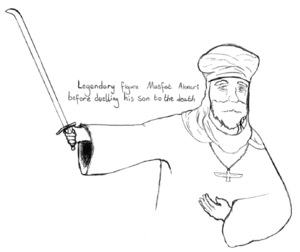Okrit
Okrit comprises a small set of islands west of the greater Attu archipelago. Okrit was formerly cut off from the rest of the world by a thick fog and storms. These weather anomalies ceased in 9 PC.
<infobox>
<title source="title1"> <default>Okrit</default> </title> <image source="image1">
</image> <group> <header>Geography</header> <label>Location</label> <label>Archipelago</label> <label>Area</label> <label>Area rank</label> <label>Highest elevation</label> <label>Highest point</label> </group> <group> <header>Administration</header> <label>Countries</label> <label>Country</label> <label>Provinces</label> <label>Largest settlement</label> </group> <group> <header>Demographics</header> <label>Population</label> <label>Population density</label> <label>Ethnic groups</label> </group> </infobox>
History
Prior to national union, political power was split between multiple states based mostly on ethnic boundaries. Directly prior to 9PC, the most powerful of these states were the predominantly Efiyye kingdom of Masrit, the Taaqbal federation and the various City States along the Omolai.
The kingdom of Masrit was founded in 564BC by it's first Udumap, Aazab Matras, who led a coalition of Efiyye city states against neighbouring tribes who frequently raided the the lands. After this successful conquest, the coalition formally united through an electoral monarchical system under the council of dukus, who elected Aazab Matras as their Udumap, with the capital, and later namesake of the nation, being the minor mining city of Masrit.
The United Okrit Government was established in 9PC by Nkrama political official Aakar Orit after the outbreak of the eastern-borne Purple Fever.
Geography
Okrit comprises an archipelago of several islands, the largest two being Waaq to the west and Onomat to the East. The capital city of Okrit, Nkrama, is situated on the eastern banks of the straight between the two, which is known as the Omolai.
Culture
Okrit has a variety of cultures and ethnicities, the main division being between the west and the eastern highlands. The highlands have been traditionally run by a variety of clans with their own respective customs, beliefs, practices & languages separate from the lowlands. The highlanders have been in conflict with each other and the lowland peoples since time immemorial. Within the highlanders, there are 14 traditional ‘clan’ denominations. They all share an amount of shared mutual influence with each other, however maintain separate identities.
The lowlander denominations make up the majority of the population and have the most cultural influence on the nation. Despite this, they do share cultural ties with the highlanders after millennia of mutual interaction. Traditionally, the lowlanders are split into 5 cultural groups excluding the Peye - the Amata, Efiyye, Oye, Ofot & Taaqbal. Within the lowlanders, the Peye are outliers, and have very few cultural ties with the mainland. This due to the Peye's relative isolation from the rest of Okrit prior to national union in 9PC.
The Efiyye

Historically, the West-most cities of the Effiya were led by hereditary rulers known as Dukus, Masriti - 'lord'. When the Efiyya united under Duku Aazab Matras the title of Udumap [from ‘uDuku mapiyye’ - 'Lord of All Men'] was established. The Efiyye are historical rivals with the Taaqbal, despite their close linguistic & cultural ties. The Efiyye have a culture of modesty and humility, prising compassion, patience and humility. These aspects of personality are usually embodied in heroes of legend and folklore, the foremost of which being the pseudo-historical figure, Masfat Akmari, whom is held in very high regard.
The Oye
Oye society is heavily concentrated around family and blood connections, and they have many strict laws and traditions around marriage, property and inheritance. Foremost to Oye society is the structure of the familial unit, the hierarchy of which is mostly built on age and perceived wisdom. Usually, the oldest & most respected living member of the family is considered the ‘Agak’, an Agak being their respective families’ matriarch/patriarch. The Agak is the spiritual head of the family, and holds great influence on the financial & marital decisions made within that family.
The Oye are polygamous; a man can have multiple wives and a woman can have multiple husbands; however only one of the primary members of a marriage can have multiple spouses. In this way, a woman from a powerful family can have multiple husbands, but only if that woman is of high social standing. Within that marriage each of one of her ‘subsidiary‘ husbands - of lower social standing - can only have one wife. This is likewise the same for men, wherein harems are common, but restricted to people of high class. This way, most peasants have monogamous marriages
The Oye are very superstitious, especially regarding dreams and black magic, the practitioners of which are referred to as ‘sakate’.
Economy
Traditionally Okrit had a closed economy, with flow maintained between the eastern and western extremities - with minerals from the west being traded for grain from the east.